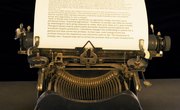A narrative speech relates the story of an event, whether from the speaker’s life or from that of someone she knows. Usually organized chronologically, narrative speeches are often given to entertain or teach the listener. In writing an effective narrative speech, start with an outline to help focus on the purpose of the speech, organize the events discussed in the speech and create a final draft.
A Statement of Purpose
Identify the purpose of your speech, such as imparting a moral or making the audience feel good. This step is necessary and saves revision, because you know where the speech is going from the beginning. It also ensures that nothing necessary is left out. Identifying your purpose can be as simple as writing a one-sentence statement at the top of the outline. Keep the statement of purpose in view and refer back to it or refine it if needed.
Your Attention Please
Grab the audience’s attention and preview the topic of the speech in the introduction. Include a hook or attention-getter, the thesis and a preview of the narrative in this order; establish credibility after the hook if you think it's important. In your outline, the introduction is Roman numeral “I,” and each part receives a capital letter under it -- A: Hook, B: Establish Credibility, C: Thesis, D: Preview. Capture the main idea of each part in one sentence, saving the details for the post-outline writing stage.
A Full Body
Ensure no essential narrative parts are missing by organizing the story carefully in the body. Outline this part of the speech in a straightforward manner by including the most important points in chronological order, adding extraneous information as necessary. Write the body as Roman numeral “II” and give each body point its own capital letter. Add numbers underneath the letters for supporting information. Use full sentences and save minute details for the writing stage.
Thank You, Ladies and Gentlemen
An abrupt stop at the end of the narrative will confuse or frustrate the audience. Use the conclusion to wrap up the speech, reminding the audience of the takeaway, if any. Include three main points: a signal that the speech is nearly finished, a summary of the story and a thesis review. Add Roman numeral “III” for the conclusion, then one capital letter for each point — A: Signal, B: Summary, C: Thesis Review. Capture the essential information in one sentence for each. When finished, review the purpose of the speech to ensure that the outline is in accordance.
Related Articles
References
Writer Bio
Melissa Harr is a writer and knitting pattern designer with a range of publication credits. Her latest work includes blogging for Smudge Yarns, judging fiction for Ink & Insights 2015 and creating patterns for I Like Knitting magazine. Harr holds a Bachelor of Arts in English from the University of Illinois at Chicago and a CELTA.










